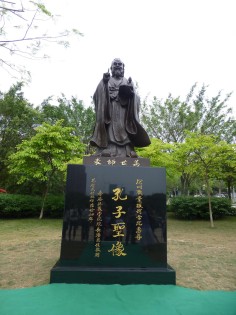Confucius returns to mainland, statue by statue
The heat was intense. As the speakers took the podium in the gardens of Shenzhen Polytechnic a young woman fainted.

The statue, donated and unveiled by 80-year-old Hong Kong businessman and billionaire Dr Tong Yun-kai, depicts the great sage Confucius with his hand raised in a traditional pose of teaching.
And as the students clustered around the statue, having their pictures taken in front of it, it seemed clear somehow that the earlier scene of two people fainting in the midday sun embodied everything Confucius taught: it emphasised the importance of ritual, the critical role of respect for authority and yet ultimately it showed the place for benevolence by those in control of events.
The unveiling of this icon represents a rather extraordinary cultural phenomenon on the mainland at the moment: the revival and rise of that particular philosophy known as Confucianism (although when Confucius taught the precepts, 2,500 years ago, they were already ancient, having been born in the Bronze Age or earlier).
"Fifteen years ago, nobody in China really mentioned Confucius," says Liu Hongyi, president of the Shenzhen Polytechnic. "Now Confucianism is culturally really important to so much we do."
All children in primary schools today learn written characters from Confucian texts and sayings; universities throughout the mainland have put Confucian studies onto the syllabus for both humanities and political studies. Around 500 Confucian temples have been built or rebuilt in China in the past couple of decades. And the government and politicians have begun to refer back as a matter of course to the great Confucian classics of the ( ) and the Analects, about how to rule with benevolence and wisdom.
For the past decade, since the first one opened in 2004, the Chinese government has been putting serious funding into hundreds of Confucian Institutes around the world. They are the equivalent of the British Council, Goethe-Institut and Alliance Francaise, and they are the main bodies representing and promoting Chinese arts and culture overseas.
According to Professor Yao Xinzhong at Renmin University, the mainland is returning to the sage's teaching because of the many problems, whether moral or environmental, it faces: "And there's a feeling that … to solve them we need to look back to our traditions. There's a sense that going back to Confucianism is going back to people's own traditions."
One of the people who have supported this resurgence of interest in Confucius is Tong, head of the Hong Kong Confucian Academy. Over the past few years, the octogenarian has donated more than 500 large outdoor statues of the 6th-century BC philosopher to universities and schools on the mainland and around the world.
"Confucianism is about being wise with your power and your money, so you don't waste them, you do something good with them," says Tong. "This is something very important for people in China to remember today. Actually it's important for anyone to remember today."
Tong was 15 when he came over the border in 1949 without a dollar in his pocket. Three years later, after finding a job in a dye factory, he had saved HK$51. He used it judiciously. He set up his own small dye business, and by the time he celebrated his 27th birthday he had constructed a nine-storey industrial building in Sham Shui Po.
He became known as Hong Kong's "King of Dyes", and then as he watched China destroy its ancient traditions during the Cultural Revolution, and then built itself into a powerful but strongly materialist nation, he became committed to the idea of promoting Confucian ideals in art and culture.
"I've given all these statues because I think sometimes it's not enough to be told ideas, sometimes you have to see them … Art helps you think about those bigger subjects you have to learn in life," says Tong, who plans to build a new Confucian temple in Hong Kong as a testimony to the revival of Confucian art and architecture.

